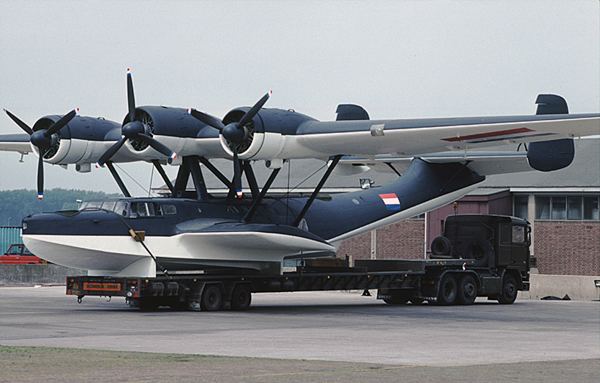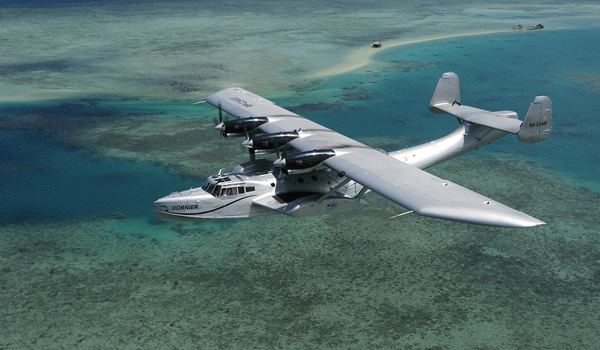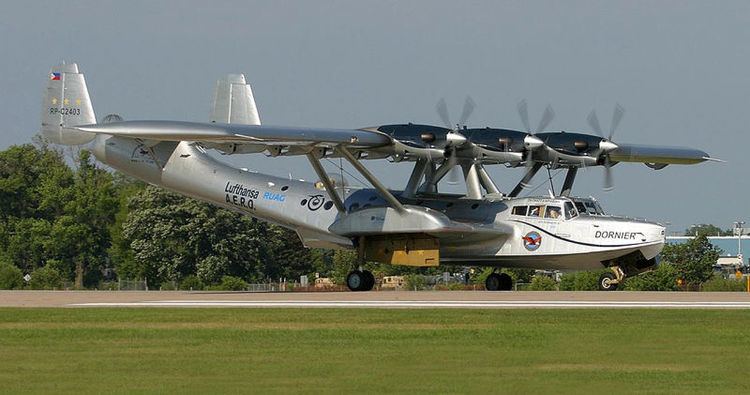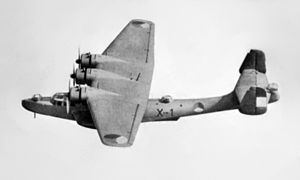Top speed 341 km/h Length 22 m First flight July 3, 1937 | Wingspan 27 m Introduced November 1937 Number of seats 6 | |
 | ||
Manufacturers Dornier Flugzeugwerke, EADS CASA, Potez, Aviolanda | ||
The Dornier Do 24 is a 1930s German three-engine flying boat designed by the Dornier Flugzeugwerke for maritime patrol and search and rescue. According to Dornier records, some 12,000 people were rescued by Do 24s during its flying career. A total of 279 were built among several factories from 1937–1945.
Contents
- Design and development
- Operation history
- Variants
- Operators
- Surviving aircraft
- Specifications Do 24T 1
- References

Design and development

The Dornier Do 24 was designed to meet a Dutch navy requirement for a replacement of the Dornier Wals being used in the Dutch East Indies, with the Netherlands government signing a contract for six Dornier Do 24s on 3 August 1936. Two more prototypes were built for the German navy to be evaluated against the Blohm & Voss BV 138.

The Do 24 was an all-metal parasol monoplane with a broad-beamed hull and stabilising sponsons. Twin tails were mounted on the upswept rear of the hull, while three wing-mounted tractor configuration engines powered the aircraft. Fuel was carried in tanks in the sponsons and the wing centre section. Up to 1,200 kg (2,600 lb) of bombs could be carried under the aircraft's wings, while defensive armament consisted of three gun turrets, one each in nose, dorsal and tail positions. In early aircraft the turrets were each fitted with a machine gun but later aircraft carried a 20 mm cannon in the dorsal turret.

Do 24 V3, the first of the Dutch boats, took off from Lake Constance on 3 July 1937, with the second Dutch boat, Do 24 V4 following soon after. As the Dutch required that their flying boats use the same engines as the Martin 139 bombers in use in the Dutch East Indies, they were fitted with 661 kW (887 hp) Wright R-1820-F52 Cyclone radial engines. Test results were good, with the new flying boat proving capable of operating from extremely rough open seas and the Dutch placed an order for a further 12 Do 24s on 22 July 1937. Do 24 V1, the first of the two aircraft for Germany, powered by three 600 hp (450 kW) Junkers Jumo 205C diesel engines, flew on 10 January 1938 but after evaluation, the two German boats were returned to Dornier for storage.

The Netherlands was enthusiastic about the new flying boat and planned to purchase as many as 90 Do 24s. Of these, 30 were to be built by Dornier (with all but the first two prototypes assembled by Dornier's Swiss subsidiary based at Altenrhein). The remaining aircraft were to be built under licence in the Netherlands by Aviolanda at Papendrecht. Of these aircraft, all but one of the German and Swiss built aircraft and the first seven Aviolanda-built aircraft were to be Do 24K-1s, powered by the original R-1820-F52 engines, while the remaining aircraft were to be Do 24K-2s, with more powerful 820 kW (1,100 hp) R-1820-G102 engines and more fuel.

Only 25 aircraft had been built on the Aviolanda assembly line before the German occupation. The Luftwaffe were interested in the completed and partially completed aircraft. The Dutch production line continued to produce aircraft under German control. 11 airframes were completed with Dutch-bought Wright Cyclone engines but later models used the BMW Bramo 323R-2. A further 159 Do 24s were built in the Netherlands during the occupation, most under the designation Do 24T-1.
Another production line for the Do 24 was established in the old CAMS factory at Sartrouville, France, during the German occupation. This line was operated by SNCAN and was able to produce another 48 Do 24s. After the liberation, this facility produced a further 40 Do 24s, which served with the French Navy until 1952.
Operation history
Thirty-seven Dutch- and German-built Do 24s had been sent to the East Indies by the time of the German occupation of the Netherlands in June 1940. Until the outbreak of war, these aircraft would have flown the tri-color roundel. Later, to avoid confusion with British or French roundels, Dutch aircraft flew a black-bordered orange triangle insignia. A Dutch Dornier Do 24 is credited with sinking the Japanese destroyer Shinonome on December 17, 1941 while the ship was escorting an invasion fleet to Miri in British Borneo. On 10 January 1942 a Dutch Dornier Do 24K spotted a Japanese invasion fleet heading for Tarakan Island in Dutch Borneo, giving adequate warning so that all oil installations could be destroyed before the Japanese arrived. After the Japanese invasion of the Netherlands East Indies, six surviving Do.24s were transferred to the Royal Australian Air Force in February 1942. They served in the RAAF through most of 1944 as transports in New Guinea, making the Do.24 one of the few aircraft serving operationally on both sides during World War II
On 31 October 1944, a German Do 24 (CM+RY of Seenotgruppe 81) made a forced landing in neutral Sweden, was impounded and eventually bought, and remained in Swedish service until 1952.
In 1944, 12 Dutch-built Do 24s were delivered to Spain with the understanding that they would assist downed airmen of both sides. After the war, a few French-built Do 24s also found their way to Spain. Spanish Do 24s were operational at least until 1967, and possibly later. In 1971, one of the last flying Spanish Do 24s was returned to the Dornier facility on Lake Constance for permanent display.
Variants
Operators
Surviving aircraft
Specifications (Do 24T-1)
Data from The Cosmopolitan Dornier...Last of the Sponson 'Boats
General characteristics
Performance
Armament
